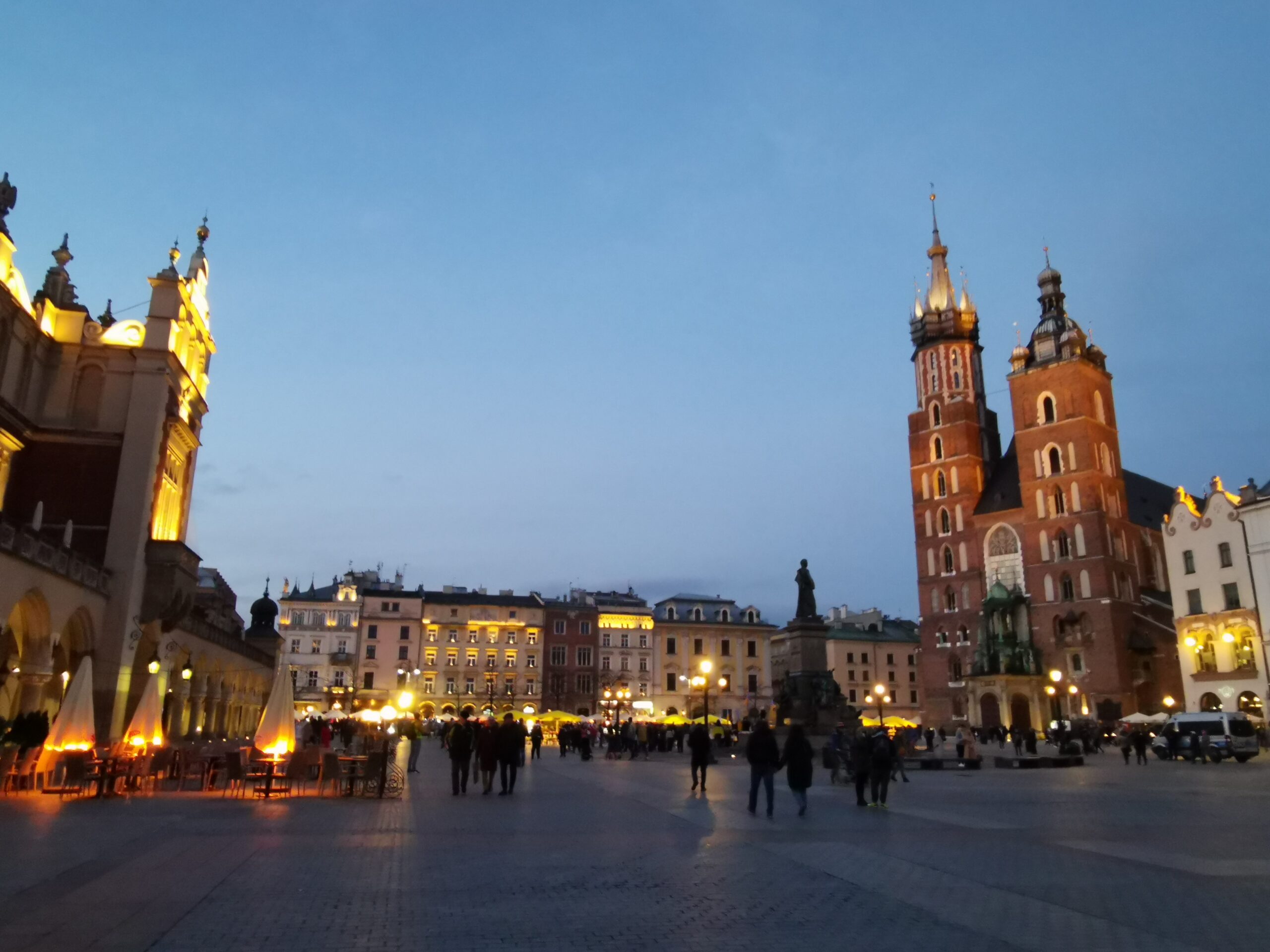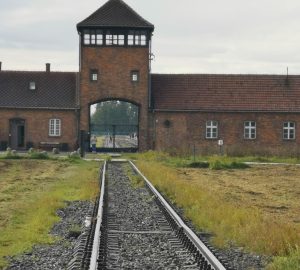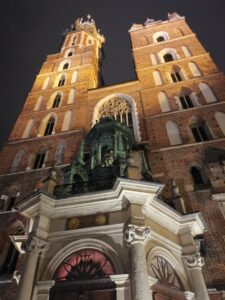Travelling to Krakow is like entering a storybook. Travellers from all over the world are enthralled by this charming city in southern Poland because it offers the ideal fusion of history, culture, and beauty.
The UNESCO-listed Old Town of Krakow is where you can explore picturesque cobblestone streets, take in the splendor of mediaeval architecture, and take in the energetic mood of the busy Rynek Gówny (Main Market Square). Architectural marvels like St. Mary’s Basilica and the venerable Cloth Hall can be found here.
A trip to Krakow wouldn’t be complete without seeing Auschwitz-Birkenau, which is nearby and has a sombre but significant history of the Holocaust. This eerie location serves as a sombre reminder of the crimes committed during World War II.
There are several museums, art galleries, and theatres to visit in Krakow, which is also a centre for culture and the arts. The Wawel Castle and Cathedral, which provide a look into Poland’s regal past, should not be missed.
The scenic Wieliczka Salt Mine and the breathtaking Tatra Mountains are two must-see destinations that highlight Poland’s natural splendour outside of the capital.
An memorable adventure that will leave you enchanted and inspired is guaranteed when you visit Krakow with its rich history, beautiful atmosphere, and variety of cultural events.
In this article, we will give you some must see attractions when you plan to visit Krakow.
Visit Auschwitz – Birkenau
This UNESCO World Heritage Site is a museum and memorial site and was a Nazi Concentration Camp during World War 2. The Auschwitz concentration camp was a complex of over 40 different extermination and concentration camps. It is located west of Krakow and it was the site of where over 1.5 million people died during the war. It was established in April of 1940 and was finally closed when the Soviet forces liberated it in January 1945.
We must never happened during the Holocaust, so this is why I think everyone should visit Auschwitz-Birkenau if you are planning a trip to Krakow. By seeing what has happened in the past, will hopefully prevent it from happening again in the future.
If you would like to book a Auschwitz-Birkenau tour to see the Auschwitz-Birkenau, click here or on the Get Your Guide image below to select from one of our preferred suppliers.
2. Explore Rynek Główny (Main Market Square)
Rynek Gówny, or Main Market Square, in Krakow is the city’s compelling and iconic center. It maintains a distinctive place in Krakow’s cultural and architectural history as one of the biggest mediaeval squares in all of Europe.
The famous St. Mary’s Basilica and the imposing Cloth Hall are only two of the magnificent architectural wonders that dominate the square. These majestic buildings transport people back in time with their fusion of Gothic and Renaissance architecture.
In addition to being a visual treat, Rynek Gówny is a hive of activity. It is surrounded by quaint cafes, eateries, and shops where you may sample traditional Polish food, gorge on regional treats, or purchase one-of-a-kind souvenirs.
The square holds a variety of events and festivals all year long, enhancing its lively atmosphere. Rynek Gówny is a centre for cultural and social activities, hosting anything from outdoor concerts and cultural celebrations to Christmas markets.
Rynek Gówny offers a memorable experience, enveloping tourists in Krakow’s rich history and energetic spirit, whether you’re touring the square during the day or taking in its captivating atmosphere at night.
3. Wawel Royal Castle and the Wawel Hill
The Wawel Royal Castle, perched magnificently on Wawel Hill, is a representation of Polish history and opulence. This architectural marvel, which can be found in the centre of Krakow, Poland, is a must-see for those who love history and culture.
The castle complex, with its massive walls, towers, and courtyards, displays a seamless fusion of Gothic, Renaissance, and Baroque styles. Throughout the years, it housed Polish kings and queens and was the scene of important historical events.
Visitors can tour the castle’s sumptuous interior and see the State Rooms, Royal Apartments, Crown Treasury, and Armoury. A window into Poland’s regal past is provided by the collection of artwork, tapestries, and royal regalia.
The Wawel Cathedral, which is next to the castle and stands out due to its elaborate design and lengthy religious history, is impressive. The cathedral, which also contains the Sigismund Bell and beautiful chapels, is where Polish kings and queens are laid to rest.
In addition to providing beautiful views over Krakow’s Old Town, the Vistula River, and the surrounding area, Wawel Hill itself is a cultural and historical gem.
Visitors can immerse themselves in Poland’s regal past and learn about the events that formed the history of the country by visiting the Wawel Royal Castle and strolling around the hill.
4. Visit St Mary’s Basilica
Located in Krakow’s Rynek Główny or also known as the Main Market Square is the St Mary’s Basilica. This brick Gothic church was built in the 14th century and is one of the oldest examples of Polish Gothic architecture in the country.
One of the biggest tourist attractions in the Main Market Square that gets everyone’s attention is trumpet player every hour on the hour from top of the tower of St Mary’s Basilica. Historically, the first trumpet call was documented in 1392 and it is said that it was done to warn the local residents of invasions or fires and when the city gates would be opening or closing.
Adults and children can buy a ticket and can go to the top of the tower where you will see amazing views over the Main Market Square. Please keep in mind that children under the age of seven are not allowed to the top of the tower for safety reasons.
5. Visit Kazimierz
In 1335, Kazimierz was founded on the outskirts of Krakow by King Kazimierz the Great. This area would become mainly a Jewish area when thousands of Jews were being forced out of Krakow and they came and settled in Kazimierz and Jewish culture thrived here for hundreds of years.
Prior to World War 2, Krakow was nearly 25% Jewish and the city had the 4th largest Jewish community the country. When the Germans entered Krakow in 1939, there were over 70,000 Jewish people living in Kazimierz and the majority of them would be forced into the Podgórze ghetto, which was located across the river in Krakow. Unfortunately, due to the war and the horrible conditions these Jewish were forced with many of them died.
Today, Kazimierz is considered one of the most trendy and hip areas in Krakow. There are loads of great pubs, hip cocktail bars and fabulous restaurants. If you want to see some of the old Jewish history, go down Szeroka Street where you will find loads of synagogues including the 16th century Old Synagogue. Another cool place to check out is the Galicia Jewish Museum, which celebrates local Jewish culture.
6. Visit Wieliczka Salt Mine
In Poland, close to Krakow, the Wieliczka Salt Mine is a remarkable underground environment that displays centuries of mining history and spectacular natural beauty. One of the world’s oldest salt mines, this UNESCO World Heritage site dates back to the 13th century.
A unique journey deep beneath may be taken by visitors to the Wieliczka Salt Mine as they explore the complex system of tunnels, chambers, and salt formations. The magnificent St. Kinga’s Chapel, which is ornamented with elaborate salt sculptures and chandeliers constructed entirely of salt crystals, is one of the mine’s attractions.
A extraordinary collection of works of art, including salt carvings and sculptures made by previous generations of miners, have been preserved thanks to the mine’s peculiar microclimate, which maintains a consistent temperature and humidity.
The history of the mine, the mining process, and the daily life of the miners are all covered in guided tours. Visitors can go below to see the huge chambers and explore the depths of the mine while also learning about the value of salt to the local economy and culture.
A trip to the Wieliczka Salt Mine provides an enthralling peek into a mysterious underground setting where history, art, and unsurpassed natural beauty are intertwined.
If you would like to book a tour of the Wieliczka Salt Mine, click here or on the Viator image below to select from one of our preferred suppliers.
7. Visit the Bochnia Salt Mine
One of the oldest salt mines in Europe is the Bochnia Salt Mine, which is situated in the Polish town of Bochnia. It is a notable example of the area’s long mining history. This UNESCO World Heritage monument, which dates to the 13th century, offers an exciting underground journey.
A maze of tunnels, chambers, and subterranean lakes that stretches for km beneath the surface can be explored by visitors to the Bochnia Salt Mine. The Chapel of St. Kinga, which is decorated with beautiful salt sculptures and gorgeous underground salt lakes, is one of the mine’s highlights.
Visitors are taken on enlightening historical tours of the mine that highlight the many mining methods that have been employed throughout the years and the daily life of the miners. You can see the striking salt formations and discover the value of salt to the local economy and culture.
The Bochnia Salt Mine is a singular and immersive experience that enables guests to explore the depths of history and comprehend the work and inventiveness involved in salt extraction. It is a well-kept secret that guarantees an incredible underground adventure.
If you would like to book a tour to see the Bochnia Salt Mine, click here or on the Klook image below to select from one of our preferred suppliers.
8. Visit Oskar Schindler’s Factory
Many people may have watched the 1993 film called Schindler’s List that was produced by Steven Spielberg and stared Liam Neeson as Oskar Schindler. If you have not seen this film and you like historical and World War 2 films then you should definitely check out this one.
Oskar Schindler’s Enamel and metal Factory that was saved over 1200 Jewish people was located in Krakow. The Enamel Factory today now houses a permanent exhibition and two museums: the Historical Museum of the City and the Museum of Contemporary Art in Krakow. If you have seen the movie then I would definitely recommend checking out Oskar Schindler’s Factory.
If you would like to book a tour to see the Oskar Schindler’s Enamel and metal factory, click here or on the Trip.com image below to select from one of our preferred suppliers.
9. Visit Ghetto Hero’s Square
A moving and important memorial honoring the Jewish victims of the Krakow Ghetto during World War II may be found in Krakow, Poland, in Ghetto Hero’s Square. It pays homage to the fortitude, struggle, and ultimate tragedy that the Jewish community endured throughout the Holocaust.
The former Podgórze Ghetto, where tens of thousands of Jews were brutally interned by the Nazi authority, is where the square is located. To represent the furniture that people who were killed or deported left behind, the memorial is made up of 33 large bronze chairs that are dispersed throughout the square.
Every chair has a separate story, a lost and halted existence. They serve as a poignant reminder of the human tragedy and the terrible effects of the Holocaust because of the emptiness and absence they arouse.
As a sombre reminder of the horrors done during that terrible era in history, Ghetto Hero’s Square is still standing today. Visitors are urged to respect the victims’ memories and work towards a future devoid of prejudice and hatred as they enter this place of reflection, recollection, and contemplation.
10. Experience Festivals in Krakow
Krakow is famous for having a thriving and varied festival scene that honours tradition, art, music, and culture. The city comes alive all year long with a variety of festivals that enthral both residents and tourists.
The Krakow Film Festival, one of Krakow’s most well-known events, features a diverse selection of foreign and Polish films, including documentaries, features, and shorts. It draws movie buffs from all around the world and gives aspiring filmmakers a platform.
The Krakow Live Festival, a music festival with both well-known worldwide performers and up-and-coming musicians, is another well-liked occasion. The event offers a dynamic and exciting atmosphere by showcasing a variety of musical styles, from rock and pop to techno and alternative.
The Misteria Paschalia Festival, which emphasises early music and features performances by renowned orchestras, choirs, and soloists, is a highlight for fans of classical music. The festival, which takes place around Easter, provides a special fusion of artistic and spiritual experiences.
Krakow also holds a number of cultural and traditional festivals, including the Jewish Culture Festival and the St. John’s Fair, which both celebrate the Jewish culture through song, dancing, and traditional crafts while commemorating the midsummer solstice.
These events in Krakow weave a colorful tapestry of cultural encounters that cater to all tastes and further the city’s standing as a center of culture in Europe.
If you want to experience one of the festivals in Krakow, click here or on the Ticketmaster banner below to book a ticket to an event or festival in Krakow.
























